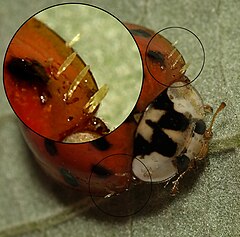Laboulbeniales
| Laboulbeniales | ||
|---|---|---|
 Laboulbeniales en Harmonia axyridis | ||
| Taxonomía | ||
| Reino: | Fungi | |
| División: | Ascomycota | |
| Clase: | Laboulbeniomycetes | |
| Orden: |
Laboulbeniales Engler (1898) | |
| Familias | ||
Laboulbeniales es un orden de hongos en la clase Laboulbeniomycetes. A veces se les denomina, polizontes de cascarudos.[1] El orden contiene unas 2325 especies[2] de ectoparásitos obligados de insectos que producen talos celulares a partir de ascoesporas de dos células. Recientemente, el género Herpomyces, tradicionalmente considerado un miembros basal de Laboulbeniales, fue transferido al orden Herpomycetales a partir de información recolectada en estudios moleculares filogenéticos.[3][4] Laboulbeniales por lo general no matan a quienes les hospedan, si bien pueden afectar la movilidad de su hospedador si la densidad de parásitos es alta.
Estudios filogenéticos moleculares recientes han determinado que algunos taxones son complejos de varias especies segregadas por el hospedador, por ejemplo Hesperomyces virescens.[5] La clasificación del orden Laboulbeniales corresponde a la definida por Isabelle Tavares (1985) aunque varios taxones de dicho sistema son polifiléticos.[6][7]
Referencias[editar]
- ↑ Cooke MC (1892). «Vegetable wasps and plant worms : a popular history of entomogenous fungi, or fungi parasitic upon insects /». Metcalf Collection (North Carolina State University). (en inglés) (Londres: Society for Promoting Christian Knowledge). doi:10.5962/bhl.title.34922.
- ↑ Kirk, Paul (2019). «Catalogue of Life».
- ↑ Haelewaters, Danny; Pfliegler, Walter P.; Gorczak, Michał; Pfister, Donald H. (2019). «Birth of an order: Comprehensive molecular phylogenetic study excludes Herpomyces (Fungi, Laboulbeniomycetes) from Laboulbeniales». Molecular Phylogenetics and Evolution (en inglés) 133: 286-301. doi:10.1016/j.ympev.2019.01.007.
- ↑ Blackwell, Meredith; Haelewaters, Danny; Pfister, Donald H. (2020). «Laboulbeniomycetes: Evolution, natural history, and Thaxter’s final word». Mycologia (en inglés): 1-12. ISSN 0027-5514. doi:10.1080/00275514.2020.1718442.
- ↑ Haelewaters D, De Kesel A, Pfister DH (2018). «Integrative taxonomy reveals hidden species within a common fungal parasite of ladybirds». Scientific Reports 8 (1): 15966. Bibcode:2018NatSR...815966H. PMC 6206035. PMID 30374135. doi:10.1038/s41598-018-34319-5.
- ↑ Goldmann L, Weir A (2018). «Molecular phylogeny of the Laboulbeniomycetes (Ascomycota)». Fungal Biology 122 (2–3): 87-100. PMID 29458722. doi:10.1016/j.funbio.2017.11.004.
- ↑ Haelewaters D, Page RA, Pfister DH (2018). «Laboulbeniales hyperparasites (Fungi, Ascomycota) of bat flies: Independent origins and host associations». Ecology and Evolution 8 (16): 8396-8418. PMC 6145224. PMID 30250711. doi:10.1002/ece3.4359.
Bibliografía[editar]
- Alexopolous CJ, Mims CW, Blackwell M (2004). Introductory Mycology (4th edición). Hoboken NJ: John Wiley and Sons. ISBN 0-471-52229-5.
- Thaxter R (1896). «Contribution towards a monograph of the Laboulbeniaceae. I.». Memoirs of the American Academy of Arts and Sciences 12: 187-429.
- Thaxter R (1908). «Contribution towards a monograph of the Laboulbeniaceae. II.». Memoirs of the American Academy of Arts and Sciences 13 (6): 217-469. JSTOR 25058090. doi:10.2307/25058090.
- Thaxter R (1924). «Contribution towards a monograph of the Laboulbeniaceae. III.». Memoirs of the American Academy of Arts and Sciences 14 (5): 309-426. JSTOR 25058114. doi:10.2307/25058114.
- Thaxter R (1926). «Contribution towards a monograph of the Laboulbeniaceae. IV.». Memoirs of the American Academy of Arts and Sciences 15 (4): 427-580. JSTOR 25058132. doi:10.2307/25058132.
- Thaxter R (1931). «Contribution towards a monograph of the Laboulbeniaceae. V.». Memoirs of the American Academy of Arts and Sciences 16: 1-435. JSTOR 25058136. doi:10.2307/25058136.
